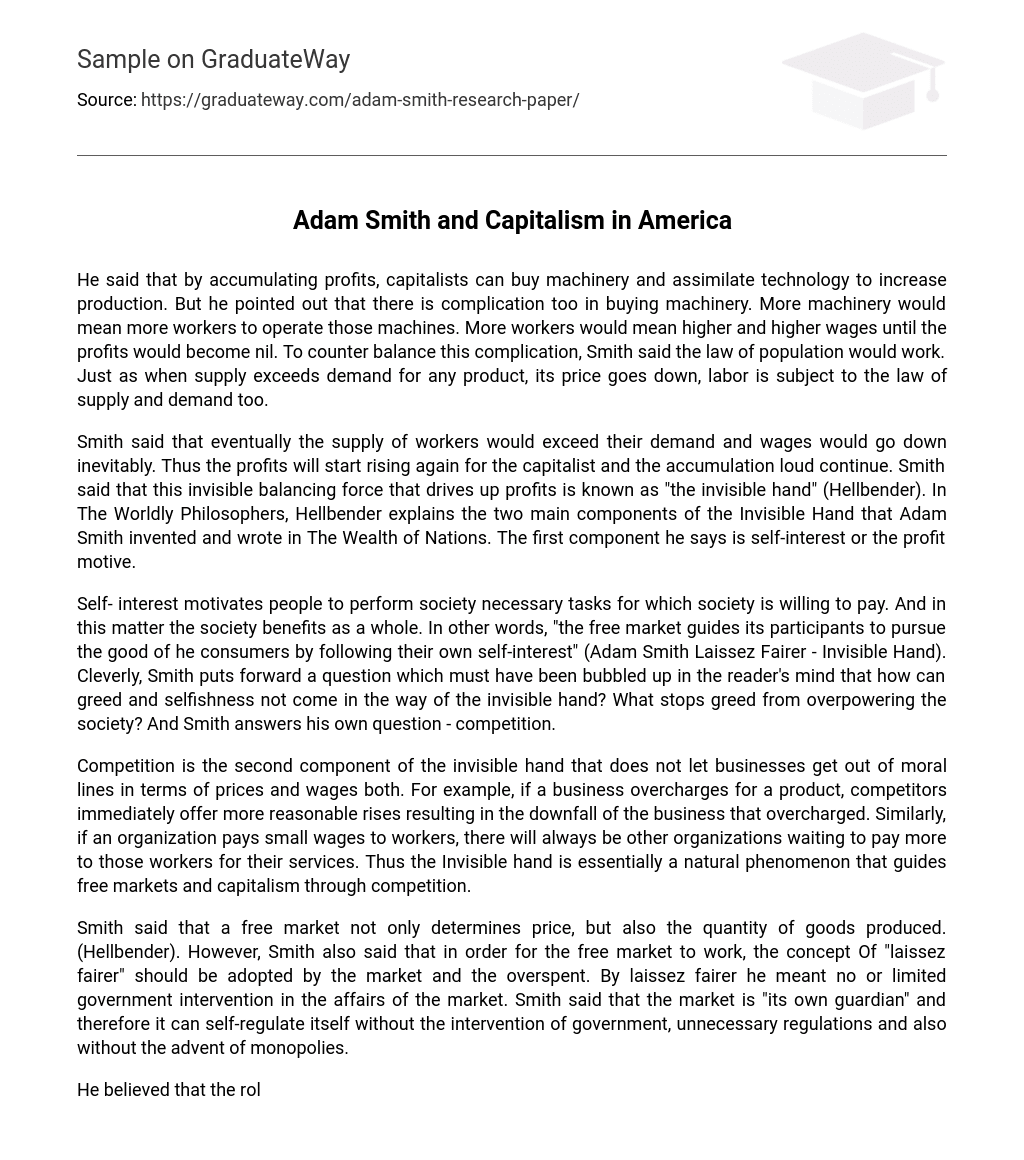He said that by accumulating profits, capitalists can buy machinery and assimilate technology to increase production. But he pointed out that there is complication too in buying machinery. More machinery would mean more workers to operate those machines. More workers would mean higher and higher wages until the profits would become nil. To counter balance this complication, Smith said the law of population would work. Just as when supply exceeds demand for any product, its price goes down, labor is subject to the law of supply and demand too.
Smith said that eventually the supply of workers would exceed their demand and wages would go down inevitably. Thus the profits will start rising again for the capitalist and the accumulation loud continue. Smith said that this invisible balancing force that drives up profits is known as “the invisible hand” (Hellbender). In The Worldly Philosophers, Hellbender explains the two main components of the Invisible Hand that Adam Smith invented and wrote in The Wealth of Nations. The first component he says is self-interest or the profit motive.
Self- interest motivates people to perform society necessary tasks for which society is willing to pay. And in this matter the society benefits as a whole. In other words, “the free market guides its participants to pursue the good of he consumers by following their own self-interest” (Adam Smith Laissez Fairer – Invisible Hand). Cleverly, Smith puts forward a question which must have been bubbled up in the reader’s mind that how can greed and selfishness not come in the way of the invisible hand? What stops greed from overpowering the society? And Smith answers his own question – competition.
Competition is the second component of the invisible hand that does not let businesses get out of moral lines in terms of prices and wages both. For example, if a business overcharges for a product, competitors immediately offer more reasonable rises resulting in the downfall of the business that overcharged. Similarly, if an organization pays small wages to workers, there will always be other organizations waiting to pay more to those workers for their services. Thus the Invisible hand is essentially a natural phenomenon that guides free markets and capitalism through competition.
Smith said that a free market not only determines price, but also the quantity of goods produced. (Hellbender). However, Smith also said that in order for the free market to work, the concept Of “laissez fairer” should be adopted by the market and the overspent. By laissez fairer he meant no or limited government intervention in the affairs of the market. Smith said that the market is “its own guardian” and therefore it can self-regulate itself without the intervention of government, unnecessary regulations and also without the advent of monopolies.
He believed that the role of the government should only be restricted in matters of national defense and security, administering justice and providing some amount of infrastructure. (Adam Smith Contributions to Economics). To understand an overall concept of how Adam Smith brought revolution in he economic world, lees discuss the three stages of capitalism. The earliest capitalism before Adam Smith’s writing of The Wealth of Nations was known as mercantilism and later it was given the title Commercial Capitalism. It lasted one hundred and fifty years from 1613 – 1767.
The main motive of this kind of capitalism was trade and government regulation of prices and interest rates. The source of profit and wealth was in the buying and selling of products and in the accumulation of gold; not in production (Rise of Mercantilism Commercial Capitalism). The second stage of capitalism was the Industrial Capitalism which began developing during the time of Adam Smith. Adam Smith made people realize that the value of a commodity is in the means of production and manufacture and not in the accumulation of gold. It lasted for the first three quarters of the nineteenth century.
The last and the final and current stage of capitalism is F-uncial Capitalism. It began from the last quarter of the nineteenth century and is still ongoing until today. Financial capitalism emerged as a result of high requirement of corporate finance needed to power the expansion of businesses that had developed ruing the industrial revolution. In order to cover the cost and funding of creating huge corporate financing operations for building factories, importing of new technology and the merging of industries, the development of stock markets, banks and other financial institutions came into place and is still flourishing today.





